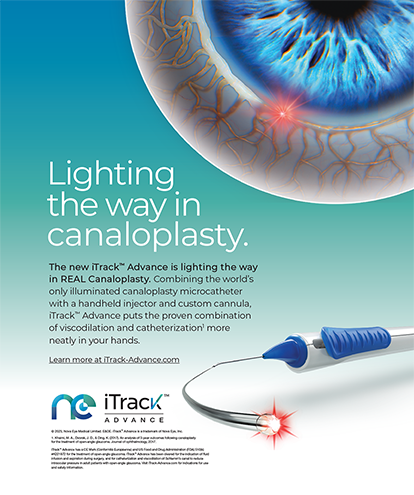
Cortical removal is a critical part of cataract surgery because retained cortex can obscure vision, incite inflammation, and contribute to rapid opacification of the posterior capsule. Cortical removal is also arguably the most delicate aspect of cataract removal, as evidenced by the relatively high frequency of capsular breaks during this step of the procedure. The following are four tips for increased safety and efficacy.
TIP NO. 1 USE THE RIGHT INSTRUMENTATION FOR YOU
Cannula
The successful removal of cortical material during cataract surgery begins with proper instrumentation. Surgeons typically use balanced salt solution placed in a 3-mL syringe with a hydrodissection cannula to facilitate the cleavage of cortex from the capsular bag. Various cannulas exist, ranging from flat 27-gauge models to curved J-shaped designs. Each surgeon should become comfortable using a cannula that allows efficient delivery of a fluid wave while minimizing the risk of capsular blowout.
The Chang Nucleus Hydrodissection Cannula (MicroSurgical Technology) designed by David Chang, MD, is a 90º angled cannula. This instrument allows subincisional fluid delivery, which I have found to be particularly helpful for loosening subincisional cortex that is notoriously difficult to remove. This cannula also propagates the fluid wave away from—rather than back toward—the corneal incision, which theoretically reduces the risk of capsular distention and blowout. Finally, a quick turn of the instrument facilitates easy rotation of the lens to confirm adequate separation from the capsule.
I/A Handpiece
After nuclear disassembly and removal, the phaco probe is replaced by the I/A handpiece, the primary instrument used to remove cortex. Irrigation and aspiration can be performed with either a bimanual or a coaxial system. Bimanual irrigation and aspiration offers superior flexibility and allows the surgeon to reach subincisional cortex and polish endothelial cells from the undersurface of the anterior capsule. It requires an additional corneal incision, however, and can be less efficient because the surgeon must change hands during the course of the procedure. Coaxial I/A access can be improved with use of curved or angled tips, but a straight tip is sufficient for some surgeons.
The novel Intrepid Transformer I/A handpiece (Alcon) is designed to allow surgeons to transition easily from coaxial to bimanual cortical removal. When in coaxial mode, a simple twist separates the handpiece into two individual components so that it can be used in bimanual mode. I have found this versatility particularly helpful during laser cataract surgery, where an absence of cortical tags can make cortical removal challenging.
Phaco Unit
The final instrument that is critical to cortical removal is the phaco unit itself. Although the typical setup is high flow and high vacuum, the most successful cortical removal takes advantage of foot-controlled flow and vacuum levels. I start with a low level of vacuum to engage cortex at the tip of the I/A handpiece toward the fornix of the capsular bag (port always facing up) and gently strip cortex via a circumferential movement toward the center of the pupil. I find it best to avoid aspirating cortex during this stripping phase. Instead, I simply aim to hold and peel the cortical material free of the capsule. After cortex is engaged with the tip of the I/A handpiece and safely located midpupil, the footpedal may be further depressed to allow additional vacuum to remove cortex from the eye.
Subincisional cortex is ideally addressed first because the remaining cortical material can help protect the posterior capsule. It can sometimes be useful to remove cortex from either side of the subincisional cortex in an effort loosen it. Occasionally, hydrodissection from an additional paracentesis or viscodissection can help. Another technique is to implant the IOL into the capsular bag and then to use the lens both to shield the posterior capsule during more aggressive irrigation and aspiration of the subincisional cortex and to help free additional lens epithelial cells or cortical adhesions from the posterior capsule.
TIP NO. 2 DON’T PANIC
Damage to the capsular bag is common during cortical cleanup. If the posterior capsule is inadvertently aspirated into the I/A port, radial striae or spiderweb-like wrinkles will be seen. To avoid rupture, the handpiece should remain still, and the footpedal should be returned to position one to stop aspiration. Occasionally, reflux (typically footpedal-controlled) is needed to free the capsule from the port. If capsular rupture occurs, the handpiece should remain still inside the eye (it is important to resist the temptation to remove it immediately in exchange for another instrument), and a dispersive OVD should be placed to tamponade vitreous prolapse.
TIP NO. 3 BE GENTLE
Overly aggressive cortical cleanup can result in zonular dialysis when cortex in the equator of the bag is aspirated and stripped toward the center of the pupil. Small areas of dialysis can often be ignored, but more significant zonular dialysis could allow vitreous prolapse, necessitating an anterior vitrectomy and placement of a capsular support device (ring or ring segment) for the IOL to be safely implanted.
TIP NO. 4 GO SLOWLY
Residual lens epithelial cells may adhere to the posterior capsule or undersurface of the remaining anterior capsule. The polish setting of the phaco unit allows very low vacuum to facilitate the gentle removal of these cells. The typical reusable I/A handpiece has a steel tip (microimperfections could actually snag and tear the posterior capsule), but most surgeons now use silicone or polymer-tipped handpieces that can engage the capsule (port down) at low vacuum and make slow, fine movements to polish any remaining cells.
CONCLUSION
Cortical removal prepares the capsular bag for IOL implantation. As IOL technology advances, surgeons must be careful to clear the visual axis of any residual cortical material that might negatively affect visual acuity or necessitate an early laser capsulotomy.




